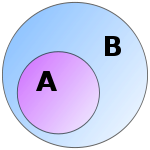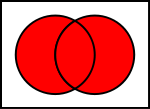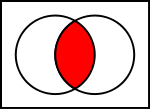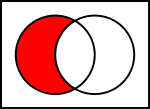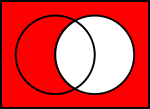
Set (mathematics)
About this schools Wikipedia selection
SOS believes education gives a better chance in life to children in the developing world too. A quick link for child sponsorship is http://www.sponsor-a-child.org.uk/
A set is a collection of distinct objects considered as a whole. Sets are one of the most fundamental concepts in mathematics. The study of the structure of sets, set theory, is rich and ongoing. Having only been invented at the end of the 19th century, set theory is now a ubiquitous part of mathematics education, being introduced from primary school in many countries. Set theory can be viewed as a foundation from which nearly all of mathematics can be derived.
In philosophy, sets are ordinarily considered to be abstract objects the physical tokens of which are, for instance; three cups on a table when spoken of together as "the cups", or the chalk lines on a board in the form of the opening and closing curly bracket symbols along with any other symbols in between the two bracket symbols. However, proponents of mathematical realism including Penelope Maddy have argued that sets are concrete objects.

Definition
At the beginning of his Beiträge zur Begründung der transfiniten Mengenlehre, Georg Cantor, the principal creator of set theory, gave the following definition of a set:
By a "set" we mean any collection M into a whole of definite, distinct objects m (which are called the "elements" of M) of our perception [Anschauung] or of our thought.
The elements of a set, also called its members, can be anything: numbers, people, letters of the alphabet, other sets, and so on. Sets are conventionally denoted with capital letters. The statement that sets A and B are equal means that they have precisely the same members (i.e., every member of A is also a member of B and vice versa).
Unlike a multiset, every element of a set must be unique; no two members may be identical. All set operations preserve the property that each element of the set is unique. The order in which the elements of a set are listed is irrelevant, unlike a sequence or tuple.
Describing sets
There are two ways of describing, or specifying the members of, a set. One way is by intensional definition, using a rule or semantic description. See this example:
- A is the set whose members are the first four positive integers.
- B is the set of colors of the French flag.
The second way is by extension, that is, listing each member of the set. An extensional definition is notated by enclosing the list of members in braces:
- C = {4, 2, 1, 3}
- D = {blue, white, red}
The order in which the elements of a set are listed in an extensional definition is irrelevant, as are any repetitions in the list. For example,
- {6, 11} = {11, 6} = {11, 11, 6, 11}
are equivalent, because the extensional specification means merely that each of the elements listed is a member of the set.
For sets with many elements, the enumeration of members can be abbreviated. For instance, the set of the first thousand positive whole numbers may be specified extensionally as:
- {1, 2, 3, ..., 1000},
where the ellipsis ("...") indicates that the list continues in the obvious way. Ellipses may also be used where sets have infinitely many members. Thus the set of positive even numbers can be written as {2, 4, 6, 8, ... }.
The notation with braces may also be used in an intensional specification of a set. In this usage, the braces have the meaning "the set of all ..." So E = {playing-card suits} is the set whose four members are ♠, ♦, ♥, and ♣. A more general form of this is set-builder notation, through which, for instance, the set F of the twenty smallest integers that are four less than perfect squares can be denoted:
- F = { n2 − 4 : n is an integer; and 0 ≤ n ≤ 19}
In this notation, the colon (":") means "such that", and the description can be interpreted as "F is the set of all numbers of the form n2 − 4, such that n is a whole number in the range from 0 to 19 inclusive." Sometimes the vertical bar ("|") is used instead of the colon.
One often has the choice of specifying a set intensionally or extensionally. In the examples above, for instance, A = C and B = D.
Membership
If something is or is not an element of a particular set then this is symbolised by ∈ and ∉ respectively. So, with respect to the sets defined above:
-
- 4 ∈ A and 285 ∈ F (since 285 = 17² − 4); but
- 9 ∉ F and green ∉ B.
Cardinality
The cardinality |S| of a set S is "the number of members of S." For example, since the French flag has three colors, |B| = 3.
There is a set with no members and zero cardinality, which is called the empty set (or the null set) and is denoted by the symbol ø. For example, the set A of all three-sided squares has zero members (|A| = 0), and thus A = ø. Though, like the number zero, it may seem trivial, the empty set is quite important in mathematics. The existence of this set is one of the fundamental concepts of axiomatic set theory.
Some sets have infinite cardinality. The set N of natural numbers, for instance, is infinite. Some infinite cardinalities are greater than others. For instance, the set of real numbers has greater cardinality than the set of natural numbers. However, it can be shown that the cardinality of (which is to say, the number of points on) a straight line is the same as the cardinality of any segment of that line, of an entire plane, and indeed of any Euclidean space.
Subsets
If every member of set A is also a member of set B, then A is said to be a subset of B, written  (also pronounced A is contained in B). Equivalently, we can write
(also pronounced A is contained in B). Equivalently, we can write  , read as B is a superset of A, B includes A, or B contains A. The relationship between sets established by
, read as B is a superset of A, B includes A, or B contains A. The relationship between sets established by  is called inclusion or containment.
is called inclusion or containment.
If A is a subset of, but not equal to, B, then A is called a proper subset of B, written  (A is a proper subset of B) or
(A is a proper subset of B) or  (B is proper superset of A).
(B is proper superset of A).
Note that the expressions  and
and  are used differently by different authors; some authors use them to mean the same as
are used differently by different authors; some authors use them to mean the same as  (respectively
(respectively  ), whereas other use them to mean the same as
), whereas other use them to mean the same as  (respectively
(respectively  ).
).
Example:
-
- The set of all men is a proper subset of the set of all people.


The empty set is a subset of every set and every set is a subset of itself:
Power set
The power set of a set S can be defined as the set of all subsets of S. This includes the subsets formed from the members of S and the empty set. If a finite set S has cardinality n then the power set of S has cardinality 2n. If S is an infinite (either countable or uncountable) set then the power set of S is always uncountable. The power set can be written as 2S.
As an example, the power set 2{1, 2, 3} of {1, 2, 3} is equal to the set {{1, 2, 3}, {1, 2}, {1, 3}, {2, 3}, {1}, {2}, {3}, ø}. The cardinality of the original set is 3, and the cardinality of the power set is 23, or 8. This relationship is one of the reasons for the terminology power set. Similarly, its notation is an example of a general convention providing notations for sets based on their cardinalities.
Special sets
There are some sets which hold great mathematical importance and are referred to with such regularity that they have acquired special names and notational conventions to identify them. One of these is the empty set. Many of these sets are represented using Blackboard bold typeface. Special sets of numbers include:
 , denoting the set of all primes.
, denoting the set of all primes. , denoting the set of all natural numbers. That is to say,
, denoting the set of all natural numbers. That is to say,  = {1, 2, 3, ...}, or sometimes
= {1, 2, 3, ...}, or sometimes  = {0, 1, 2, 3, ...}.
= {0, 1, 2, 3, ...}. , denoting the set of all integers (whether positive, negative or zero). So
, denoting the set of all integers (whether positive, negative or zero). So  = {..., -2, -1, 0, 1, 2, ...}.
= {..., -2, -1, 0, 1, 2, ...}. , denoting the set of all rational numbers (that is, the set of all proper and improper fractions). So,
, denoting the set of all rational numbers (that is, the set of all proper and improper fractions). So,  . For example,
. For example,  and
and  . All integers are in this set since every integer a can be expressed as the fraction
. All integers are in this set since every integer a can be expressed as the fraction  .
. , denoting the set of all real numbers. This set includes all rational numbers, together with all irrational numbers (that is, numbers which cannot be rewritten as fractions, such as
, denoting the set of all real numbers. This set includes all rational numbers, together with all irrational numbers (that is, numbers which cannot be rewritten as fractions, such as 
 and √2).
and √2). , denoting the set of all complex numbers.
, denoting the set of all complex numbers.
Each of these sets of numbers has an infinite number of elements, and  . The primes are used less frequently than the others outside of number theory and related fields.
. The primes are used less frequently than the others outside of number theory and related fields.
Basic operations
Unions
There are ways to construct new sets from existing ones. Two sets can be "added" together. The union of A and B, denoted by A ∪ B, is the set of all things which are members of either A or B.
Examples:
-
- {1, 2} ∪ {red, white} = {1, 2, red, white}
- {1, 2, green} ∪ {red, white, green} = {1, 2, red, white, green}
- {1, 2} ∪ {1, 2} = {1, 2}
Some basic properties of unions are:
-
- A ∪ B = B ∪ A
- A ⊆ (A ∪ B)
- A ∪ A = A
- A ∪ ø = A
- A ⊆ B if and only if A ∪ B = B
Intersections
A new set can also be constructed by determining which members two sets have "in common". The intersection of A and B, denoted by A ∩ B, is the set of all things which are members of both A and B. If A ∩ B = ø, then A and B are said to be disjoint.
Examples:
-
- {1, 2} ∩ {red, white} = ø
- {1, 2, green} ∩ {red, white, green} = {green}
- {1, 2} ∩ {1, 2} = {1, 2}
Some basic properties of intersections:
-
- A ∩ B = B ∩ A
- A ∩ B ⊆ A
- A ∩ A = A
- A ∩ ø = ø
- A ⊆ B if and only if A ∩ B = A
Complements
Two sets can also be "subtracted". The relative complement of A in B (also called the set theoretic difference of B and A), denoted by B \ A, (or B − A) is the set of all elements which are members of B, but not members of A. Note that it is valid to "subtract" members of a set that are not in the set, such as removing green from {1,2,3}; doing so has no effect.
In certain settings all sets under discussion are considered to be subsets of a given universal set U. In such cases, U \ A, is called the absolute complement or simply complement of A, and is denoted by A′.
Examples:
-
- {1, 2} \ {red, white} = {1, 2}
- {1, 2, green} \ {red, white, green} = {1, 2}
- {1, 2} \ {1, 2} = ∅
- If U is the set of integers, E is the set of even integers, and O is the set of odd integers, then the complement of E in U is O, or equivalently, E′ = O.
Some basic properties of complements:
-
- A ∪ A′ = U
- A ∩ A′ = ∅
- (A′ )′ = A
- A \ A = ∅
- A \ B = A ∩ B′
Cartesian product
A new set can be constructed by associating every element of one set with every element of another set. The Cartesian product of two sets A and B, denoted by A × B is the set of all ordered pairs (a, b) such that a is a member of A and b is a member of B.
Examples:
- {1, 2} × {red, white} = {(1,red), (1,white), (2,red), (2,white)}
- {1, 2, green} × {red, white, green} = {(1,red), (1,white), (1,green), (2,red), (2,white), (2,green), (green,red), (green,white), (green,green)}
- {1, 2} × {1, 2} = {(1,1), (1,2), (2,1), (2,2)}
Some basic properties of cartesian products:
- A × ∅ = ∅
- A × (B ∪ C) = (A × B) ∪ (A × C)
- |A × B| = |A| × |B|
Applications
Set theory is seen as the foundation from which virtually all of mathematics can be derived. For example, structures in abstract algebra, such as groups, fields and rings, are sets closed under one or more operations.
One of the main applications of naive set theory is constructing relations. A relation from a domain A to a codomain B is nothing but a subset of A × B. Given this concept, we are quick to see that the set F of all ordered pairs (x, x2), where x is real, is quite familiar. It has a domain set  and a codomain set that is also
and a codomain set that is also  , because the set of all squares is subset of the set of all reals. If placed in functional notation, this relation becomes f(x) = x2. The reason these two are equivalent is for any given value, y that the function is defined for, its corresponding ordered pair, (y, y2) is a member of the set F.
, because the set of all squares is subset of the set of all reals. If placed in functional notation, this relation becomes f(x) = x2. The reason these two are equivalent is for any given value, y that the function is defined for, its corresponding ordered pair, (y, y2) is a member of the set F.
Axiomatic set theory
Although initially the naive set theory, which defines a set merely as any well-defined collection, was well accepted, it soon ran into several obstacles. It was found that this definition spawned several paradoxes, most notably:
- Russell's paradox - It shows that the "set of all sets which do not contain themselves," i.e. the "set"
 does not exist.
does not exist. - Cantor's paradox - It shows that "the set of all sets" cannot exist.
The reason is that the phrase well-defined is not very well-defined. It was important to free set theory of these paradoxes because nearly all of mathematics was being redefined in terms of set theory. In an attempt to avoid these paradoxes, set theory was axiomatized based on first-order logic, and thus the axiomatic set theory was born.
For most purposes however, the naive set theory is still useful.
Mathematical realism
Penelope Maddy has suggested that sets can be causally efficacious, and in fact share all the causal and spatiotemporal properties of their elements. Thus, when I see the three cups on the table in front of me, I also see the set as well. She used recent work in cognitive science and psychology to support this position, pointing out that just as at a certain age we begin to see objects rather than mere sense perceptions, there is also a certain age at which we begin to see sets rather than just objects.
